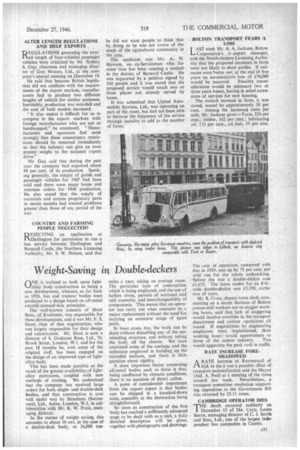Weight-Saving in Double-deckers
Page 33

If you've noticed an error in this article please click here to report it so we can fix it.
ONE is inclined to look upon lightalloy body construction as being a new development, whereas, as far back as 1926, bus and tramcar bodies were produced to a design based on all-metal aircraft-stressed-skin principles.
The well-known concern of Short Bros., of Rochester, was responsible for these developments, and it was Mr. F. S. Short, then of that organization, who was largely responsible for their design and construction. Mr. Short is now a director of S. Grahame Ross, Ltd., 76, Brook Street, London, W.1, and for the past 18 months he, with some of the original staff, has been engaged on the design of an improved type of lightalloy, body.
This has been made possible as the result of the greater availability of lightalloy extrusions, coupled with new methods of riveting. We understand that the company has received large orders for both singleand double-deck bodies, and that construction is now well under way by Strachans (Successors), Ltd., Acton, London, W.3, in collaboration with Mr. R. W. Frost, managing director.
In the matter of weight saving, this amounts to about 10 cwt. in the case of a double-deck body, or 36,000 ton
mites a year, taking an average route. The particular type of construction which is being employed, and the' use of hollow rivets, permits of sectional and unit assembly, and interchangeability of components. This means that an operator can carry out what amounts to .a major replacement without the need for carrying an extensive range of spare parts.
In most gases, too, the wink can be done-without disturbing any of the surrounding structure, and without taking the body off the chassis. We have examined some of the castings, and the technique employed in building up the extruded sections, and there is little question about rigidity.
A most important factor concerning bodies such as these is that, being unaffected by climatic conditions, there is no question of deteri. cation. A point of considerable importance from the export aspect is that bodies can be shipped in a knocked-down state, assembly at the destination being straightforward. So soon as construction of the first body has reached a sufficiently advanced stage to be dealt with as a unit, a fully detailed description will be given, together with photographs and drawings.
The cost of operation, compared with that in 1939, was up by 75 per cent, per mile run for the whole undertaking. -.Before the war a double-decker cost £1,675. The latest tender for an 8-ft.wide double-decker was £3,350, exclusive of tyres.
Mr. R. Crute, deputy town clerk, commenting on a recent decision of Bolton cotton-mill workers not to stagger working hours, said that lack of staggering would involve overtime in the transport department and costlier operations all round. If negotiations by engineering employees were implemented, their working hour.; would approximate To those of the cotton industry. This would aggravate the peak rush in traffic.
RATE INCREASE FORESHADOWED A RATE increase at Rasvtenstall of
4id. in the f. was a possible effect of transport nationalization said the Mayor (Aid. A. Peel) at a meeting of the town council last week. Nevertheless,, a transport committee resolution supporting opposition to the Government Bill was reversed by 12-11 votes.
CAMBRIDGE OPERATOR DIES
THE death occurred suddenly on December 15 of MR. CECIL JAMES Slort-H, managing director of C. J. Smith and Sons, Ltd., one of the largest independent bus companies in Cambs.




































































